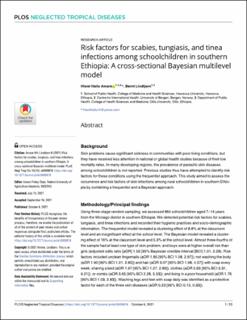| dc.contributor.author | Amare, Hiwot Hailu | |
| dc.contributor.author | Lindtjorn, Bernt | |
| dc.date.accessioned | 2022-02-21T12:43:06Z | |
| dc.date.available | 2022-02-21T12:43:06Z | |
| dc.date.created | 2021-12-03T14:04:36Z | |
| dc.date.issued | 2021 | |
| dc.identifier.issn | 1935-2727 | |
| dc.identifier.uri | https://hdl.handle.net/11250/2980519 | |
| dc.description.abstract | Background: Skin problems cause significant sickness in communities with poor living conditions, but they have received less attention in national or global health studies because of their low mortality rates. In many developing regions, the prevalence of parasitic skin diseases among schoolchildren is not reported. Previous studies thus have attempted to identify risk factors for these conditions using the frequentist approach. This study aimed to assess the occurrence and risk factors of skin infections among rural schoolchildren in southern Ethiopia by combining a frequentist and a Bayesian approach.
Methodology/Principal findings: Using three-stage random sampling, we assessed 864 schoolchildren aged 7–14 years from the Wonago district in southern Ethiopia. We detected potential risk factors for scabies, tungiasis, and tinea infections and recorded their hygienic practices and socio-demographic information. The frequentist model revealed a clustering effect of 8.8% at the classroom level and an insignificant effect at the school level. The Bayesian model revealed a clustering effect of 16% at the classroom level and 5.3% at the school level. Almost three-fourths of the sample had at least one type of skin problem, and boys were at higher overall risk than girls (adjusted odds ratio [aOR] 1.55 [95% Bayesian credible interval [BCI] 1.01, 2.28). Risk factors included unclean fingernails (aOR 1.85 [95% BCI 1.08, 2.97]); not washing the body (aOR 1.90 [95% BCI 1.21, 2.85]) and hair (aOR 3.07 [95% BCI 1.98, 4.57]) with soap every week; sharing a bed (aOR 1.97 [95% BCI 1.27, 2.89]), clothes (aOR 5.65 [95% BCI 3.31, 9.21]), or combs (aOR 3.65 [95% BCI 2.28, 5.53]); and living in a poor household (aOR 1.76 [95% BCI 1.03, 2.83]). Washing legs and feet with soap daily was identified as a protective factor for each of the three skin diseases (aOR 0.23 [95% BCI 0.15, 0.33]).
Conclusions/Significance: We observed high variation in skin problems at the classroom level, indicating the presence of shared risk factors in these locations. The findings suggest the need to improve children’s personal hygiene via health education by schoolteachers and health workers. | en_US |
| dc.language.iso | eng | en_US |
| dc.publisher | Public Library of Science | en_US |
| dc.rights | Navngivelse 4.0 Internasjonal | * |
| dc.rights.uri | http://creativecommons.org/licenses/by/4.0/deed.no | * |
| dc.title | Risk factors for scabies, tungiasis, and tinea infections among schoolchildren in southern Ethiopia: A cross-sectional Bayesian multilevel model | en_US |
| dc.type | Journal article | en_US |
| dc.type | Peer reviewed | en_US |
| dc.description.version | publishedVersion | en_US |
| dc.rights.holder | Copyright 2021 Amare, Lindtjorn | en_US |
| dc.source.articlenumber | e0009816 | en_US |
| cristin.ispublished | true | |
| cristin.fulltext | original | |
| cristin.qualitycode | 1 | |
| dc.identifier.doi | 10.1371/JOURNAL.PNTD.0009816 | |
| dc.identifier.cristin | 1964399 | |
| dc.source.journal | PLoS Neglected Tropical Diseases | en_US |
| dc.relation.project | NORHED: ETH 13/0025 | en_US |
| dc.identifier.citation | PLoS Neglected Tropical Diseases. 2021, 15 (10), e0009816. | en_US |
| dc.source.volume | 15 | en_US |
| dc.source.issue | 10 | en_US |

